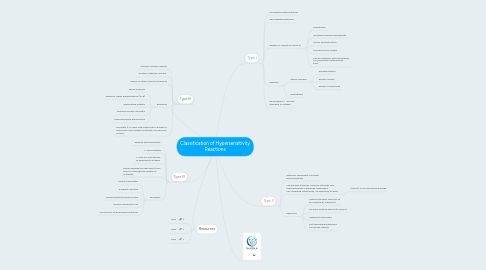
1. Type III
1.1. Immune complex disease
1.2. Antigen-antibody reaction
1.3. causes systemic immune response
1.4. Examples
1.4.1. Serum sickness
1.4.2. Systemic Lupus Erythematosus (SLE)
1.4.3. Rheumatoid arthritis
1.4.4. Leukocytoclastic vasculitis
1.4.5. Hypersensitivity penumonitis
1.5. Develops 4-10 days after exposure to antigen. If exposure to the antigen continues, can become chronic
2. Type IV
2.1. Delayed hypersensitivity
2.2. T-cell mediated
2.3. T-cells are activated by re-exposure to antigen
2.4. Tissue damage through direct toxic effect or through the release of cytokines
2.5. Examples:
2.5.1. Contact dermatitis
2.5.2. Allograft rejection
2.5.3. Hypersensitivity peneumonitis
2.5.4. Immune response to TB
2.5.5. Some forms of drug hypersensitivity
3. Resources
3.1. Here
3.2. Here
3.3. Here
4. Type I
4.1. Immediate hypersensitivity
4.2. IgE mediated response
4.3. Release of mediators result in:
4.3.1. vasodilation
4.3.2. Increased capillary permeability
4.3.3. Mucus hypersecretion
4.3.4. Smooth muscle spasm
4.3.5. Tissue infiltration with eosinophils, TH2, and other inflammatory cells
4.4. Example
4.4.1. Atopic diorders
4.4.1.1. Allergig Asthma
4.4.1.2. Allergic rhinitis
4.4.1.3. Allergic conjuctivitis
4.4.2. Anaphylaxis
4.5. Developed in < 1hr after exposure to antigen
5. Type II
5.1. antibody-dependent cytotoxic hypersensitivity
5.2. The antigen-antibody complex activates cells that participate in antibody-dependent cell-mediated cytotoxicity, complement, or both.
5.2.1. It results in cell and tissue damage
5.3. Examples:
5.3.1. Hyperacute graft rejection of an organ/graft transplant
5.3.2. Coombs-positive hemolytic anemia
5.3.3. Hashimoto thyroiditis
5.3.4. Anti-glomerular basement membrane disease
